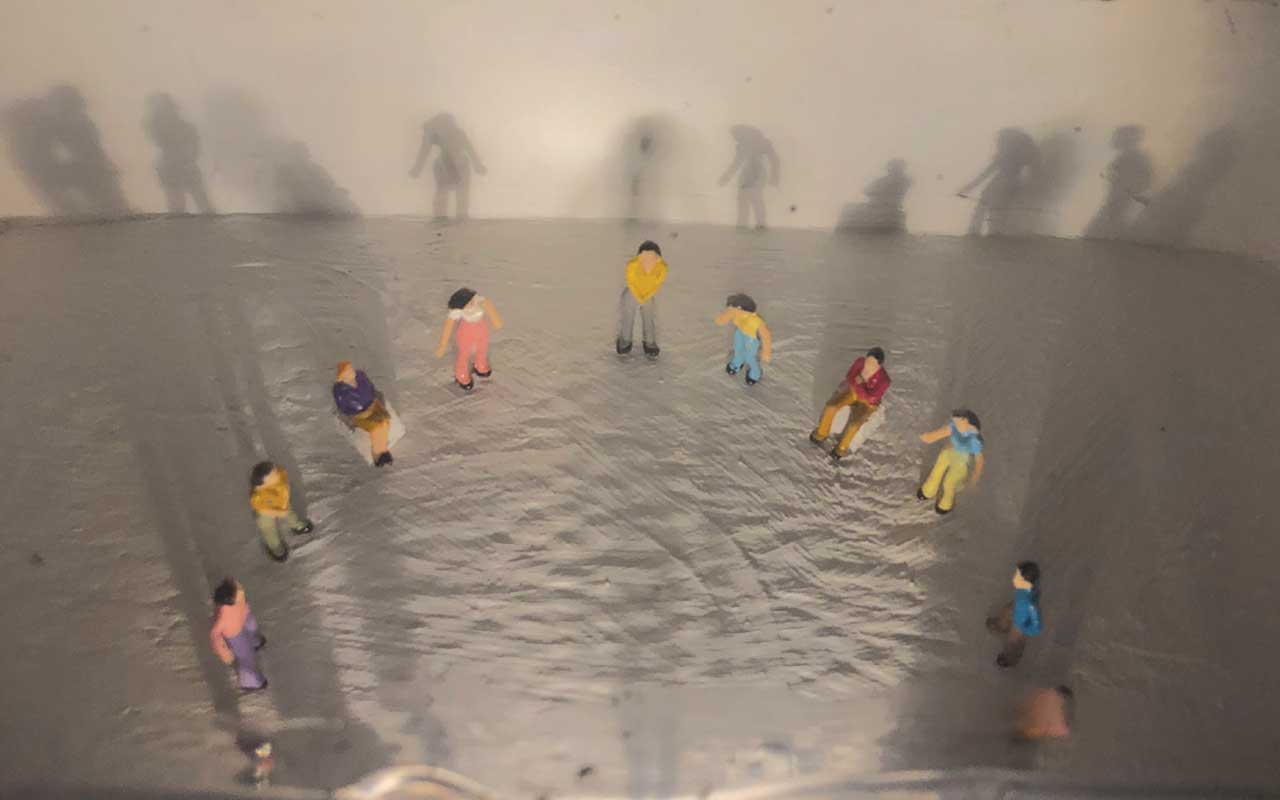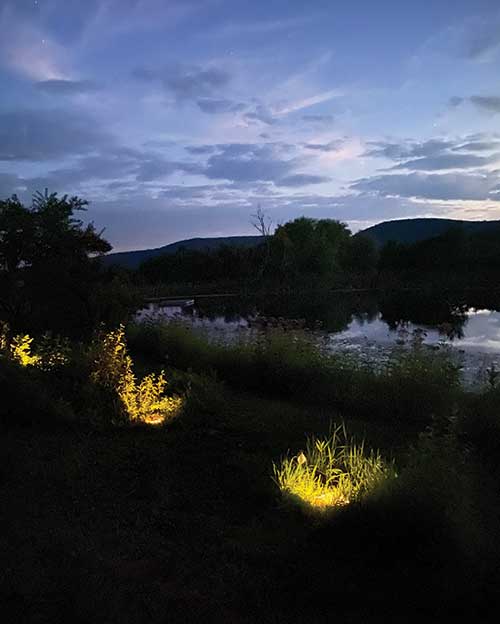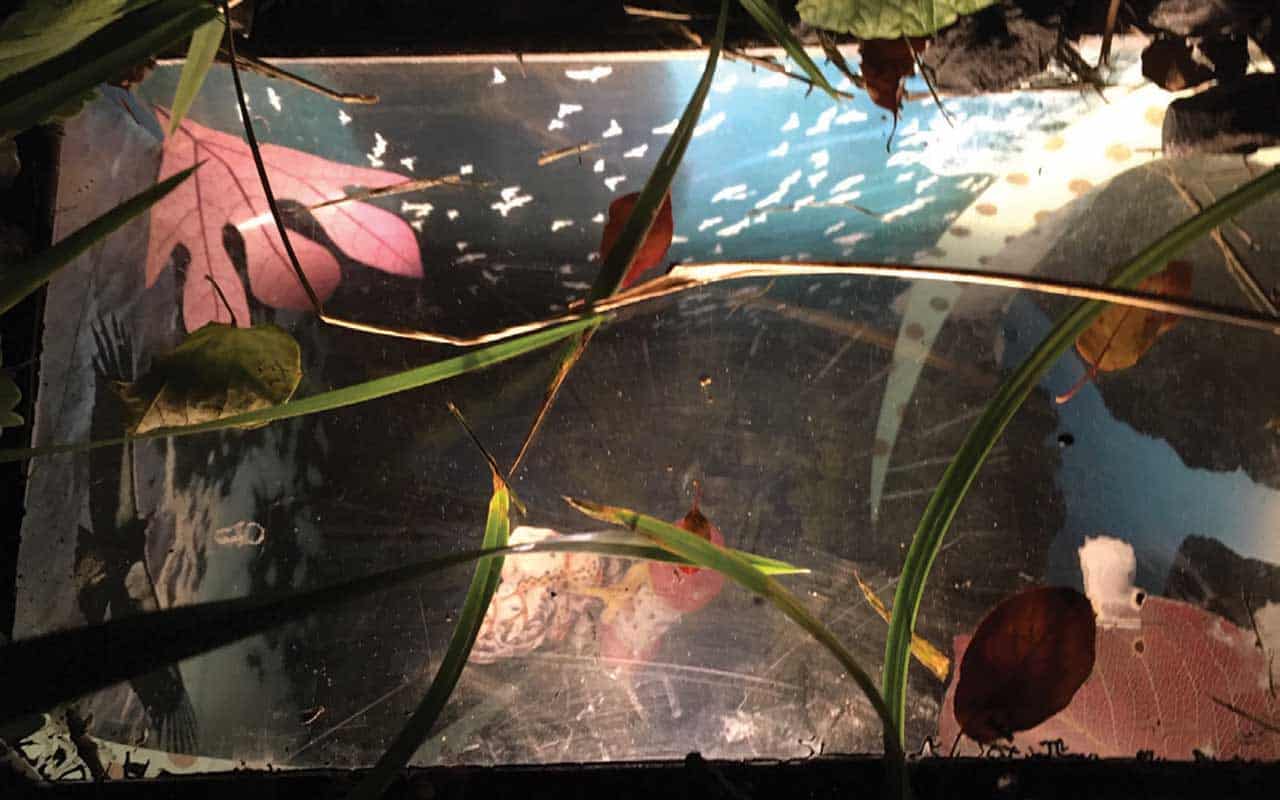Featured Artist

Take Thee to the Re
How cool is an exhibition of art that is outside at night?
How fantastic to arrive at an old farm at dusk, a sliver of a moon perched in an indigo sky – a tableau wonderful enough in itself to be the experience – the magic of the night just starting to unfold?
How amazing for an artist to transform his land and home into a statement about the precariousness of our times with this inside-out experience?
It’s so cool and so fantastic and so amazing and so original that, well, you simply must go.
What’s the Re Institute?
When I first learned about it, surreptitiously as usual, I knew I had to go. A friend and I found our way to The Re Institute at 1395 Boston Corners Road in Millerton, NY, on a lovely mid-summer night that started with a picnic in Roe Jan Park in Hillsdale. It was already an unusual outing, as typically the viewing of a show would precede a shared meal and discussion of the works. As we ate our salads and indulged in a soft, coral-on-green sunset all around us at the park, we could only speculate about what we might see, which of course heightened the anticipation.
 We had a reservation to see the show at 8:45pm. We arrived a few minutes early, and, after parking where we hoped was the right spot because already the increasing darkness was disorienting, we put on our masks, got out of the car, and were soon greeted by The Re Institute’s founder and creator of the show, Henry Klimowicz. Henry hopped off his tractor looking more the farmer than a gallery owner, and ducked inside the barn to get us each a program that listed the names of the exhibiting artists.
We had a reservation to see the show at 8:45pm. We arrived a few minutes early, and, after parking where we hoped was the right spot because already the increasing darkness was disorienting, we put on our masks, got out of the car, and were soon greeted by The Re Institute’s founder and creator of the show, Henry Klimowicz. Henry hopped off his tractor looking more the farmer than a gallery owner, and ducked inside the barn to get us each a program that listed the names of the exhibiting artists.
We talked about COVID, of course, and what led Henry to create this exhibition. “I’m acutely aware, as we all are,” he explained, “of the effects of isolation and the inability to gather and touch. I would normally have shows in the barn here,” he said, “but I can’t do that for now, so I started thinking of what I could do instead. How could I bring artists who are in isolation together somehow?” Together in Isolation was hatched.
Why Together in Isolation?
Henry’s objective for the exhibition is clearly and perfectly expressed on the Re Institute’s website, too: “Objective: To continue creativity while participating in an exhibition that mirrors our collective experiences. To produce a long-term record of this time of isolation, hardship, and sadness. To find glimmers of hope.”
My friend and I could see the exhibition coming to life and were eager to explore and observe. Henry led us from where we’d parked around to the front of his big barn and said, “Start here, follow the path to the pink pill – you’ll know it when you see it – then cut back and work your way over around the pond. You’ll finish with the works on the other side of the barn.”
The 50+ works currently on display are all housed in same-sized vitrine boxes that are then buried in the ground with a solar light beside them that illuminates them in the dark. To see the show, you walk along the path and look into the boxes. And look at the surroundings. And look at the sky. And listen to the crickets and cicadas and the voice of your friend, and your own voice, and maybe, in the distance, the low voices of others. You feel grasses and branches as you move through the dark, and dew on your feet if you’ve chosen (unwisely, FYI) to wear flip-flops, as I did.
The effect is truly Together in Isolation on many levels. The boxes themselves, of course, are self-contained, their contents isolated by design and intention. What’s inside the boxes is unique; trapped in time; buried. But buried alongside many other similar boxes, each beckoning with a beam of light that is a shared, collective invitation – the glimmer of hope Henry was looking for.
Seeing the show
Some of the pieces have been in the ground for a while, as the show opened in late April. They bear the signs of time underground…weeds have started to cover their tops, condensation sometimes blurs the work. The voices of these pieces are muted, but that seems perfectly appropriate and, for me, added to the experience. I found myself bending closer and holding back some overgrown grasses to get a better look, or moving around a piece to examine it from a better angle.
To keep visitors safe and comfortable, Henry takes reservations for individuals or small groups in 15-minute increments so that there isn’t a worry about getting too close to strangers. Of course, masks are required. But the pacing of people through the show means you essentially walk the grounds at your leisure. And while the pieces are provocative and engaging, so is the property. In the dark, with the solar lights mirroring the brightest stars in the sky, the reflection of the night sky on the still surface of the pond, the temperature change taking everything down a notch, there’s a very magical feel to the place and the experience. Taking close looks deep down at the artists’ responses to the pandemic, stuffed into boxes with the disconcerting fear we’re collectively experiencing, wondering what it’s like for them, each of them, all of us, it’s such a relief to be able to turn away and look up and around and be soothed by the land and sky, comforted by the darkness.

The artists and art
Who are the artists participating in the show, and how did Henry involve them? An artist himself (with a few boxes in the show, too), Henry has been running the Re Institute on his 40-acre working farm since 2010. Always a place with the intention to bring together visual artists, filmmakers, writers, composers, dancers, and outdoor installation artists to promote “new perspectives, understandings, and insights in the arts within this unique and historical rural landscape,” Henry is part of a network of artists who were intrigued and eager to participate.
He’s philosophical about the contributions. “I take the pieces as they come in,” he said, “and it’s unpredictable. Some artists have been unable to work during the pandemic; some want to do several pieces and turn in one; some aren’t sure at all but then get a piece here sooner than expected. It’s all fine,” he reflected. “There’s plenty of room for more pieces.” He believes that “everyone is an artist,” and so anyone can contribute (there’s specific guidance on the website).
What’s the trajectory for the show? Henry doesn’t know for now when the show will be over. It depends, like its subject, on the pandemic. “When we can have enough people together for a closing, rather than an opening,” he muses, “then it’ll be time. We’ll bring the boxes inside, but they won’t be for sale. I want them to be a record of this unique time.”

The lure and lore of the location
October is possibly the most perfect time to see the show, as there’s another fascinating aspect of the property and location. It’s in Boston Corner, originally part of Massachusetts, which it borders (along with Connecticut). It’s an area once known as Hell’s Acre because it was notoriously difficult to get to and therefore to oversee by the state of Massachusetts. Finally, in 1853, “a heavyweight championship prizefight was held that resulted in the transfer of a town from Massachusetts to the state of New York.” All kinds of things happened in little Boston Corner, and exploring the lore before exploring Together in Isolation could make for an even more haunting experience in October. (Learn more about Boston Corner’s history at www.trivia-library.com/b/history-of-boston-corner-new-york).
It was close to 9:30 when we left the Re Institute, our heads and hearts full as only art can make them. And it was very dark. And we couldn’t access the GPS. So unless you want to become part of Boston Corner’s magic and mystery, we suggest writing down the directions from the farm to the nearest main road in the area, Route 22, just in case.
In conclusion, this is something Henry wrote about the show that I particularly like: “We strive to record our lives and to bring meaning to the present. We do this through the production of artifact. Some of the work presented may talk directly to the experience of loss and isolation. Other pieces may be the record of one artist’s present interests. Some may be a wonderful treasure that the finder/participant will be given as reward for their search.” •
Learn all about the Re Institute, Together in Isolation, how to participate if you’re so inclined, and how to sign up to see the show on Henry’s website, www.thereinstitute.com.
